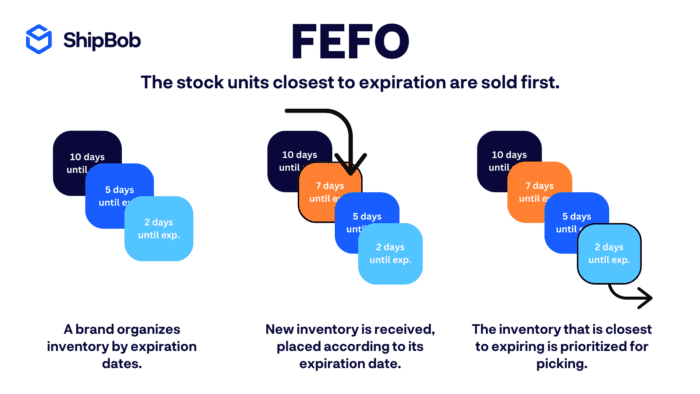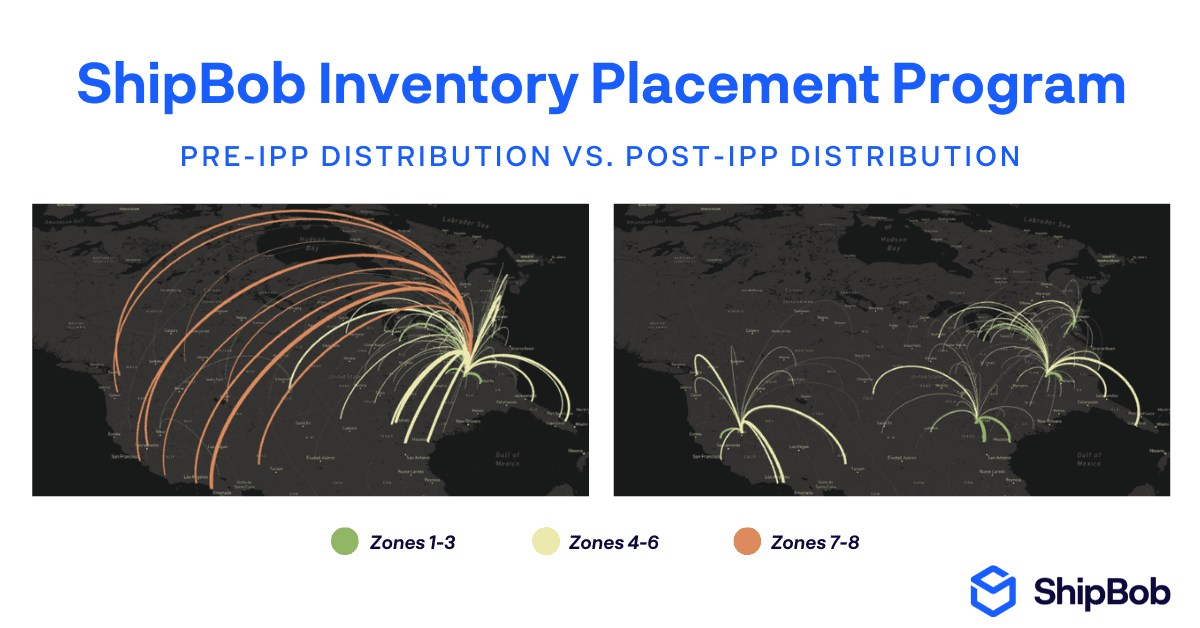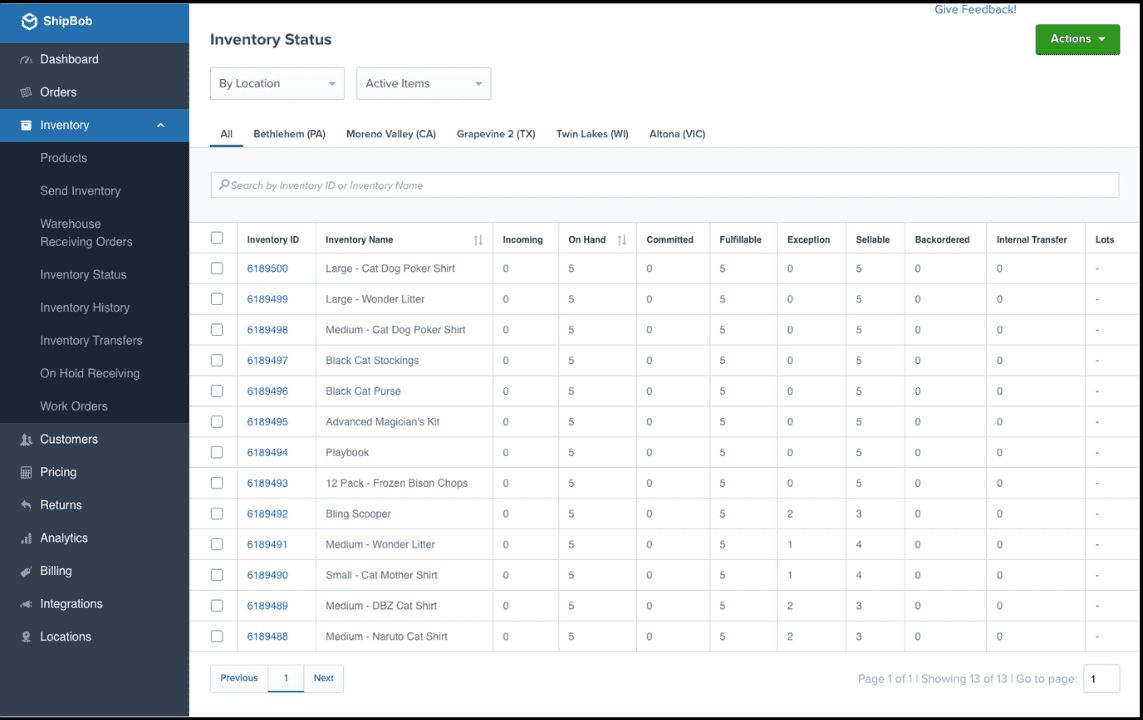Table of Contents
** Minutes
How FEFO inventory management works
Benefits of FEFO for inventory management
Why implementing FEFO with ShipBob makes sense for growing brands
For businesses handling perishable or time-sensitive goods, having the right inventory management systems and methods in place is crucial. Wasted stock due to expired products, compliance risks, and dissatisfied customers can cripple just about any business. That’s why First Expired, First Out (FEFO)—a method that prioritizes selling inventory based on expiration dates—helps minimize waste and maximize product quality.
In this guide, we’ll provide a detailed breakdown of how FEFO works, how it compares to FIFO, steps for implementation, and how ShipBob’s infrastructure supports businesses adopting this method.
What does FEFO mean?
FEFO, or First Expired, First Out, is an inventory management method where products with the earliest expiration dates are sold or used first. This approach is particularly useful for businesses handling perishable goods, pharmaceuticals, cosmetics, and other time-sensitive products.

FEFO vs. FIFO: key differences and best use cases
While both FEFO and FIFO help optimize inventory flow, they serve distinct purposes. Below are a few key differences between both methods:
| FEFO (First Expired, First Out) | FIFO (First In, First Out) |
| Prioritizes items with earliest expiration dates | Moves oldest stock first, regardless of expiration |
| Reduces waste and risk of non-compliance | Ensures older inventory is used before newer stock |
| Used in perishable product industries like food & pharmaceuticals | Best for non-perishable goods like apparel & electronics |
How FEFO inventory management works
Implementing FEFO requires careful planning, accurate tracking, and strict expiration control. This can be done using a combination of warehouse organization, the proper technology, and trained staff to ensure products are sold before expiration.
Steps to implement FEFO in a warehouse setting
To successfully implement FEFO, businesses need to establish clear procedures for tracking, storing, and rotating inventory. Below are seven steps to integrate FEFO into your ecommerce warehousing operations:
- Labeling and lot tracking: Assign batch numbers and expiration dates to each SKU. Implement lot tracking to enable accurate inventory oversight, paired with robust SKU management practices.
- Optimize warehouse layout: Arrange inventory using dynamic storage strategies to ensure easy access to products nearing expiration.
- Automated expiration alerts: Utilize a WMS to receive notifications when items are approaching expiration.
- Strict stock rotation: Regularly check and reposition inventory to prioritize products with earlier expiration dates.
- Employee training: Ensure warehouse staff understands expiration-based picking and prioritization.
- Regular inventory reevaluation: Periodically assess both your beginning inventory and on-hand stock to prevent bottlenecks.
- Monitor warehouse capacity: Prevent overstocking and optimize storage allocation for time-sensitive products.

The role of technology in supporting FEFO inventory management
The primary tool for enabling efficient FEFO inventory management is a WMS. A solid WMS (combined with broader warehouse management strategies) makes FEFO much easier to manage by keeping track of expiration dates, automating stock movement, and reducing mistakes. Instead of relying on manual checks, businesses can use technology to track inventory in real-time, making sure products don’t sit around too long.
A FEFO-optimized WMS can streamline inventory management by:
- Tracking expiration dates automatically: A WMS keeps expiration dates logged, so businesses can focus on selling products before they go bad.
- Sending automated alerts for expiring stock: If an item is about to expire, the system notifies the team, so they can prioritize selling or moving that inventory.
- Improving picking and packing efficiency: By organizing products based on expiration dates, the WMS helps warehouse staff pick the right items quickly and accurately.
- Enhancing inventory management decisions: Businesses can review stock levels, assess fast-moving vs. slow-moving products, and adjust purchasing based on expiration trends.
Benefits of FEFO for inventory management
For the right types of businesses, implementing FEFO offers several advantages. From cost savings to happier customers, let’s explore how FEFO transforms inventory management for brands dealing with perishable, regulated, or time-sensitive goods.
Minimize waste and reduce costs
By selling products before they expire, businesses can significantly reduce the financial loss associated with expired or unsellable inventory. Warehousing and storage costs decrease because inventory is constantly turning over rather than accumulating. FEFO also helps prevent overstocking by ensuring that inventory is efficiently managed, reducing dead stock and unnecessary bulk storage.
Ensure compliance with health and safety standards
Industries such as food, healthcare, and pharmaceuticals must comply with strict regulations that require products to be used or sold before expiration. Failure to follow these guidelines can lead to hefty fines, legal complications, and reputational damage. FEFO ensures that products are rotated appropriately, reducing the risk of non-compliance. Implementing a FEFO system can also improve safety inspections by providing clear documentation of expiration tracking.
Enhance product quality and customer satisfaction
Customers expect high-quality, fresh, and safe products, especially in industries dealing with perishable goods. FEFO prevents expired or near-expired products from reaching consumers, reducing the likelihood of complaints, refunds, or damaged brand reputation. By consistently delivering fresh products, businesses can enhance customer trust and brand loyalty.
Why implementing FEFO with ShipBob makes sense for growing brands
ShipBob helps ecommerce brands implement FEFO seamlessly with its advanced fulfillment network and technology. By integrating automation, real-time tracking, and an extensive list of fulfillment center locations, ShipBob ensures that perishable and time-sensitive products are stored, managed, and shipped efficiently.
Advanced WMS with FEFO-compatible tracking and expiration management
ShipBob’s warehouse management system (WMS) supports FEFO by implementing key automation and tracking features, including:
- Expiration & lot tracking: Batches are labeled and monitored via ShipBob’s WMS, ensuring earliest-expiring items are prioritized.
- Automated stock rotation: ShipBob’s technology auto-selects inventory by expiration date, minimizing errors and boosting efficiency.
- Real-time visibility: A live dashboard lets brands track stock, set alerts, and make data-driven decisions to avoid overstock or spoilage.
“We use the FEFO (First Expired, First Out) method of inventory management, meaning that we want to prioritize picking inventory units that have the earliest expiration date. Thankfully, ShipBob’s default logic is designed to always ship items with the nearest listed expiration date first, so that works out perfectly. At our scale, it would be impossible to manually check the expiration date of every single unit we ship, so leveraging ShipBob’s lot capabilities gives us much more peace of mind.”
– Neil Blewitt, SVP of Operations at Bloom Nutrition
Distributed inventory placement to minimize transit times

By leveraging distributed inventory, ShipBob places inventory closer to customers, reducing transit times for time-sensitive products. This means:
- Faster delivery, reducing the risk of products expiring before reaching customers.
- Lower shipping costs by cutting down on long-distance shipments.
- Improved regional fulfillment flexibility, allowing businesses to meet customer demand more efficiently.
ShipBob’s Inventory Placement Program (IPP) ensures that brands can distribute their inventory strategically, balancing supply chain efficiency with reduced lead times.
Real-time inventory visibility and data-driven insights

ShipBob’s dashboard provides live insights into stock levels, expiration timelines, and demand forecasting. This allows businesses to make data-driven decisions, preventing stockouts, avoiding excess inventory, and even enabling discounting of aging products. This level of insight also helps optimize restocking strategies, ensuring that supply aligns with demand.
Customizable packing solutions to maintain product integrity

ShipBob’s Customization Suite provides tailored packaging solutions to help preserve product integrity. Businesses dealing with fragile or temperature-sensitive goods can use protective packing materials and specialized handling protocols to reduce spoilage and damage during shipping.
ShipBob also enables branding customization, allowing companies to enhance the unboxing experiences while maintaining high-quality protection for their goods.
Flexible shipping options to match customer expectations
With ShipBob’s extensive carrier network and 2-day Express Shipping, ecommerce brands can meet customer demands for fast and reliable delivery. For perishable goods, reducing shipping delays is critical, and ShipBob’s infrastructure ensures on-time deliveries with minimal disruptions.
By leveraging multiple fulfillment centers and strategic carrier partnerships, brands can offer expedited shipping at competitive rates. Additionally, businesses can provide customers with real-time tracking updates, improving transparency and overall shopping satisfaction.
“From expanding into a second ShipBob fulfillment center, we are excited to be able to offer 65% of our customers with 2-day shipping, up from 32% by only having a single West Coast facility. Soon, this will be 100%. Not only is this better for our customers but we also gain a 13% savings to our bottom line.”
Pablo Gabatto, Business Operations Manager at Ample Foods
Get started with ShipBob
Connect with our team to get started with ShipBob’s global omnichannel fulfillment platform.
First expired, first out inventory FAQs
How does ShipBob support FEFO inventory management?
ShipBob offers real-time expiration tracking, smart stock rotation, and distributed inventory to help brands efficiently manage FEFO inventory.
Why is FEFO important in the food and pharmaceutical industries?
FEFO ensures compliance with strict safety and quality regulations by preventing expired products from reaching consumers. It helps businesses reduce waste by prioritizing items with the earliest expiration dates, ultimately reducing financial losses. This method also enhances customer trust by guaranteeing that they receive fresh, safe, and high-quality products.
Who should follow the FEFO method?
Businesses handling perishable goods—including food, cosmetics, pharmaceuticals, and medical supplies—should implement FEFO to maintain product integrity. Even non-perishable businesses with limited shelf-life items, such as skincare and certain electronics, may find FEFO useful.
How does the FEFO inventory management method impact supply chain efficiency?
FEFO streamlines inventory flow by reducing waste, preventing unnecessary overstocking, and optimizing storage costs. By ensuring that older products are sold first, businesses can maintain better cash flow and reduce losses from unsellable inventory. In some cases, on-demand warehousing can also be combined with FEFO principles, offering more flexible storage solutions as inventory needs shift.








